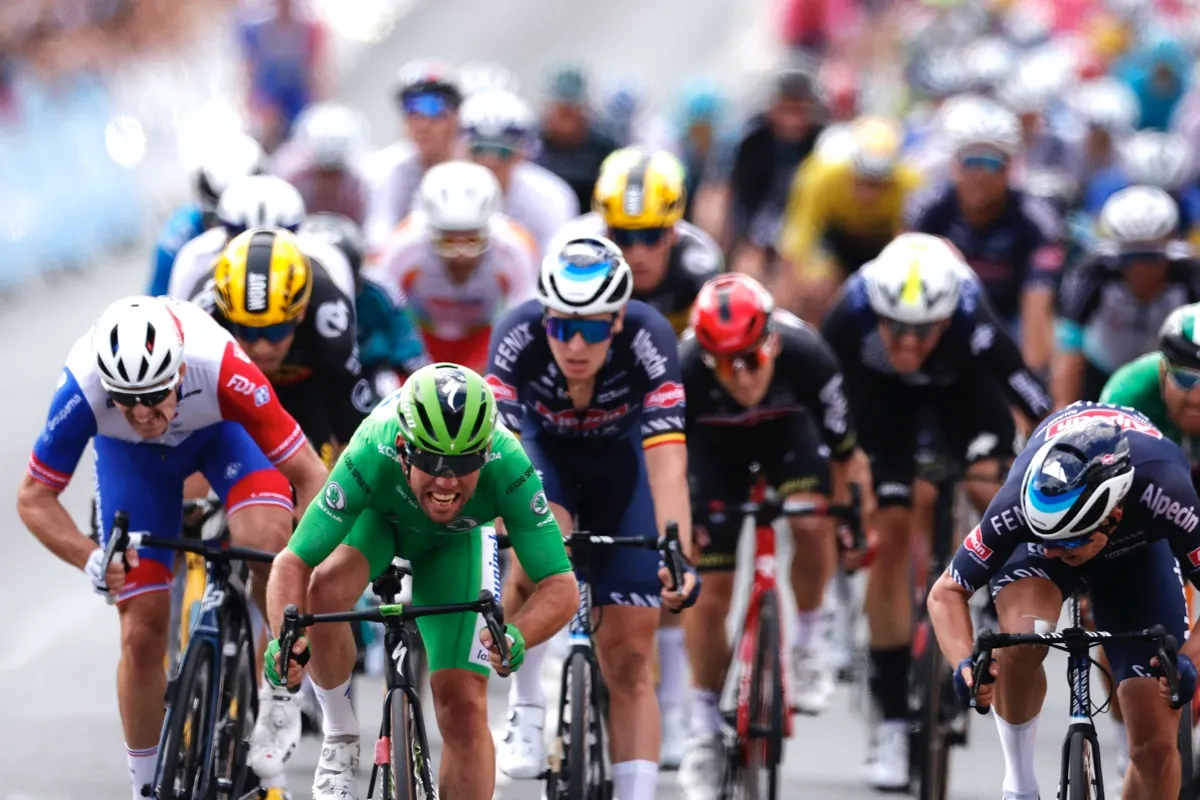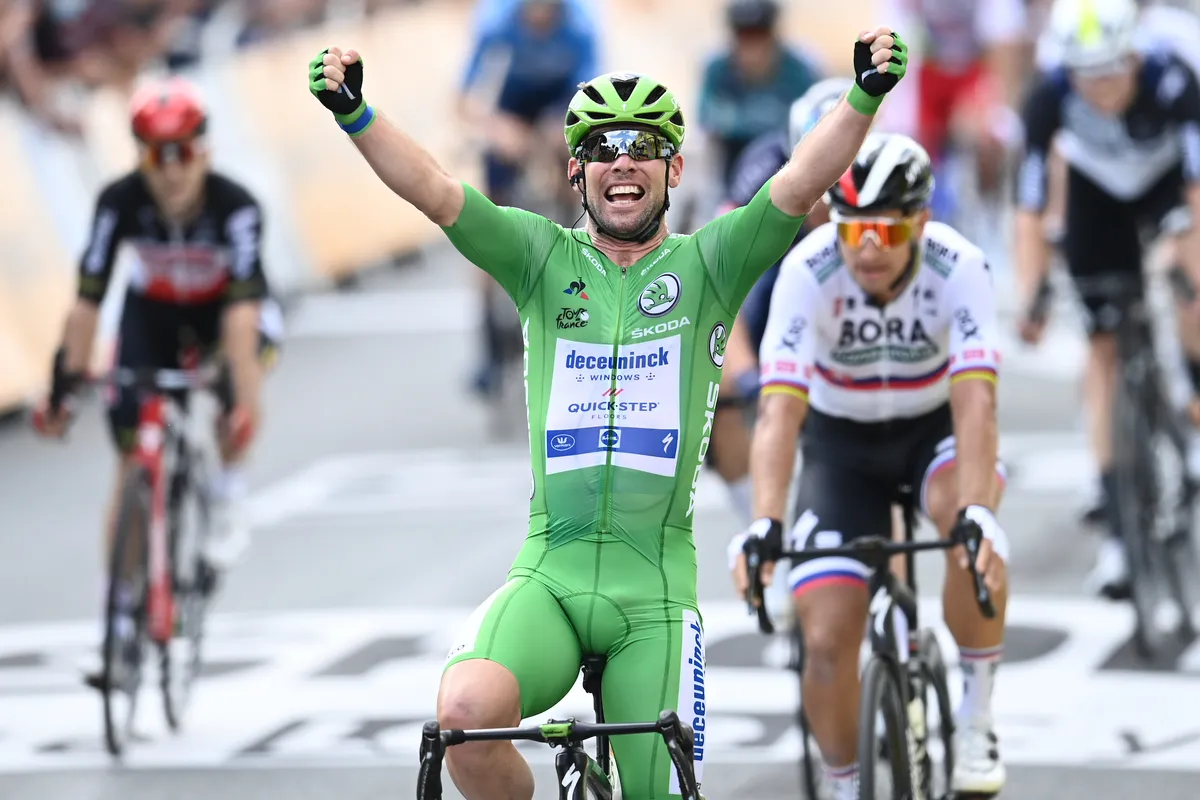There’s no denying it, Mark Cavendish is a sprinting legend, and his recent return to form at the Tour de France has only cemented that.
Alongside Chris Hoy on the track, he has a sprinting prowess that few riders can rival. And admit it, you would love to be able to sprint as fast as these two titans of the sport.
Of course, few of us have the talent to hit 40mph in a sprint without the help of a downhill gradient – or an engine. But that’s not to say we can’t dream, make the best of what we’ve got and spend hours in front of the mirror practising our finish line salute.
What types of sprinter are there? Track vs road
Mark Cavendish and Chris Hoy are both super-fast, but they’re super-fast in different ways.
As a six-time Olympic gold medallist on the track, Hoy made his name by being awesome from a standing start. The track sprinting he excelled at leans heavily on explosive power, muscle strength and coordination.

Even in the kilo (the one-kilometre time trial in which Hoy won his first gold medal before the event was dropped from the Olympics, the key facets are a good start and an ability to maintain the effort without fatiguing excessively. This type of sprinter doesn’t necessarily have a great need for endurance, in the same way Cavendish does.
Consider yourself a Hoy-esque sprinter if you’re always beating your mates, or other commuters on the ride to work, away from the lights or are explosive from a standing start.
Although Cavendish's beginnings were on the track, he later established himself as the world’s best road-race sprinter. This doesn't seem to be a title he's going to relinquish soon, either – if ever.
Cavendish is well suited to road sprinting as he can compete for hours in the saddle, yet still generate a maximal effort at the end of a hard race (or in the middle of a grueling three-week Grand Tour).
Cavendish clearly has a very strong endurance base (and an excellent team in the form of Deceuninck–Quick-step to protect him until the final few hundred metres), but he also has plenty of explosive power for the final launch to the line and can use his anaerobic energy systems better than most (we'll come on to the science).

Both track and road sprinters have high absolute power outputs, though you're likely to see a higher all-out wattage from a hulking track sprinter. As a lightweight road racer, Cavendish needs to carefully consider his ability to ride for hour upon hour, day after day, and over high mountains. Power-to-weight ratio still matters for sprinters in a stage race.
If you want to improve your sprinting, there are a number of things to work on. While power is clearly important, technique – underpinned by good coordination – is also vital. Cavendish has a reputation for his race craft and is able to win sprints, regardless of whether he is delivered to the line by a perfect leadout or has to surf the wheels of other teams.
Practice makes perfect here. If you want to excel in this area, practice, practice, practice. However, remember that good technique is best learned when feeling fresh, not when fatigued.
How to train like a sprinter
There are plenty of specific training sessions you can do to improve your acceleration and all-out sprint.
From increasing your top-end speed to working on your technique, we have outlined some of the best ways to improve your sprint below. Exercises off the bike can also help improve your sprinting.
Hill sprints
Working against a gradient means that energy input doesn’t diminish as the effort goes on. Aim for between four and eight seated maximal efforts of 20-40 seconds (build to the top end of the range as your fitness improves)
These efforts should ideally be done in a bigger gear, and have five minutes of light riding for full recovery between each one. To allow for fitness improvements, find a hill where you’re able to have a fast-rolling start. You can then progress to a slower start to the effort or even a standing start.
Jumps
In order to improve acceleration, jumps work on both power and lactate tolerance. These sessions are often best done with a partner of a similar standard.
Start by riding at a fairly fast pace, then aim for a set of six sprint accelerations of 10 seconds each, with a short, 10-second recovery in between each sprint. With progress, these sets can be repeated two or three times, with five minutes of recovery between sets.
Go long
If you want to work on your ability to close down a break, then try extended interval training.
These intervals are great on the road with a power meter but also done at home on a smart trainer. We've got separate guides to indoor cycling, the best indoor training apps, and the best workouts and training plans for Zwift.
The aim is to sustain the highest possible power for three minutes, without starting too slowly or fading too much. At this duration, it's all about pacing your maximal effort and a power meter or smart trainer can help, particularly if you know your training zones.
If you don’t have a power meter, just try the hardest effort you can sustain for three minutes. Repeat this three to six times, with a three-minute recovery in between.
The science bit
Pure sprint efforts last from just a few seconds to a maximum of around 30 seconds. Therefore, your immediate or short-term energy generation systems play a big role.
For the first second or two of a sprint, you’ll use the high-energy compound –and basic unit of energy in the body – ATP (Adenosine Triphosphate). After that, stored ATP runs out.
For sprints peaking at around 10 seconds, your body switches to another compound, creatine phosphate (CP), to produce more ATP. All of this is done without the need for oxygen –in other words, anaerobically.
Beyond 10 seconds of sprinting, ATP is produced by the breakdown of carbohydrates in a process called glycolysis. This in turn produces pyruvate. In normal endurance riding, the oxygen you take in helps convert pyruvate into even more ATP.
However, when you’re sprinting and not getting enough oxygen to your cells, the pyruvate is broken down into lactate for rapid energy. It doesn’t take long for lactic acid to build up at a faster rate than your body can use it, so the dreaded ‘burn’ starts and a rapid loss of energy and power will soon occur.
Play racing
It’s worth repeating that practice makes perfect, so break up a long group ride with riding mates using a series of prearranged sprints. Try using a road sign as a finishing line or a safe point on a short lap, for example.
After each sprint effort, bring the pace down for five minutes to allow recovery, before gradually building again for the next sprint effort. Sessions such as this can be organised to develop team tactics and practice leading out a nominated rider, or used as individual efforts to hone the perfect sprinting technique.
Of course, staying safe on the road is of up most importance, so ride with care and within your limits. If you have a closed road circuit near you, that's the perfect venue for this type of training.
Get tracking
Many clubs have access to outdoor tracks with qualified coaches, while British Cycling run open track sessions at Manchester and Newport velodromes (for more information, visit the British Cycling website).
These sessions are great for developing all kinds of riding skills (especially group riding, pedalling technique and cadence), but, due to the nature of track riding, will mostly focus on higher intensity efforts and will undoubtedly help next time you come to sprint.
The bottom line

The physiology of sprinting is not as complex or trainable as endurance performance as you’re using energy stored in the body and once it’s gone it’s pretty much gone. You can’t top up when you’re riding flat-out, and even if you could somehow take on an energy gel or drink, it wouldn’t have an effect anyway.
Having said this, there are still plenty of exercises and activities you can do to improve your sprint technique, strength and, ultimately, speed.
And if you do, maybe that finish line salute practice will pay off, too.